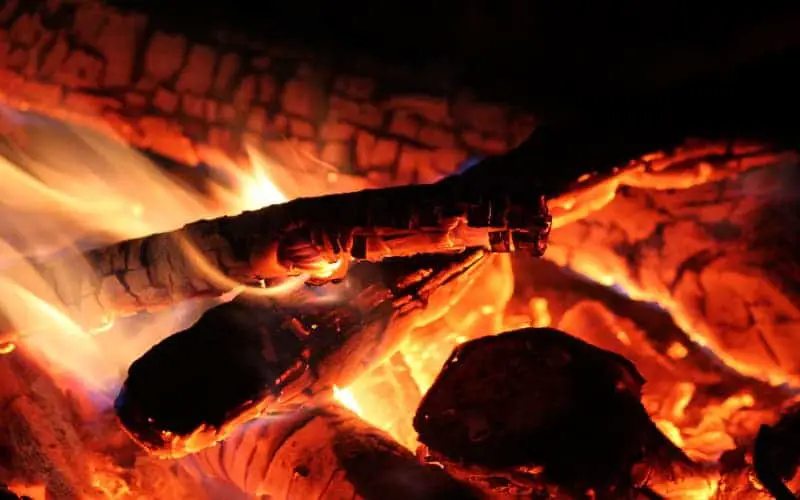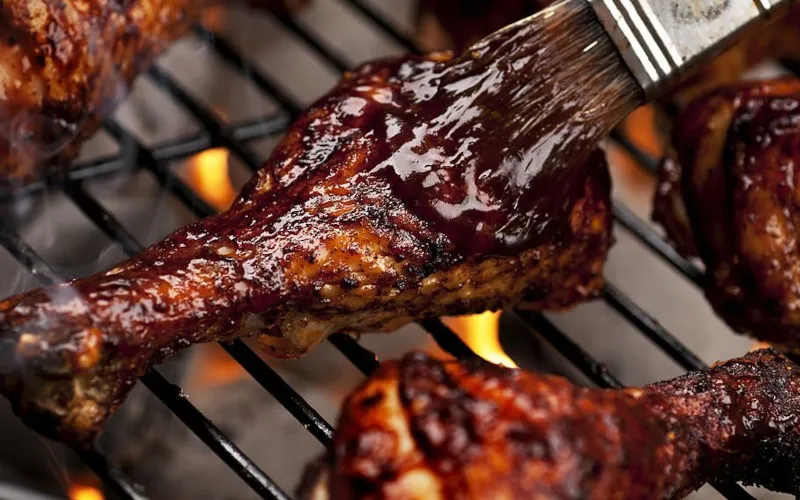Before you can determine whether or not a reverse flow smoker is where you need to go, you need to understand it is. In this article, I will explore what is a reverse flow smoker and what makes them comparable to other smokers.
What is a Reverse Flow Smoker?
A reverse flow smoker is a barbecue smoker that uses air pressure to drive air farther into the smoker in order to obtain a more uniform temperature throughout.
The heat leaves the firebox on the side and travels under a sealed drip pan towards the other end of the smoker. It goes through the cooking chamber in the opposite direction before exiting the firebox end of the smoker.
How Does A Reverse Flow Smoker Work?
A reverse flow smoker seeks to create a uniform cooking chamber. It does this by forcing hot air and smoker underneath a metal plate known as a baffle. The heat comes back through the cooking chamber, eventually escaping back to the firebox through a vent on the same side as the firebox.
How do I know if it’s a Reverse Flow Smoker or Regular Offset?
The significant difference between an offset smoker and a reverse flow smoker is the chimney stack location. Offsets have stacks that are opposite of the firebox. Meanwhile, reverse flows have stacks that are on the same side as the firebox.
The baffle forces the heat to the left, up, and back to the right side (where the stack is). The directions are not always in this order.
Remember the Science of Heat
To understand better how this smoker style works, you must first understand how heat operates. Heat typically moves in three different modes:
- Conduction
- Convection
- Radiation
For our purpose, we need to focus on convection.
Convection tells us that hot air is a substance that can flow (like water). Convection is specific to how heat operates in the presence of gravity. When it comes to air, we consider where it moves based on density.
Hot air is more active and less dense. As a result, hot air is naturally encouraged to move up. On the contrary, cold air is encouraged to move down. That is why your smoke is always trying to escape out of your chimney stack.
Applying this knowledge to a reverse flow smoker means that the heat spends more time flowing. It flows to all ends of the smoker, allowing for a consistent heat flow below the metal sheet, eventually traveling to the top layer.
Do You Need This Kind of Smoker?
Typically speaking, you do not need a reverse flow smoker. You can cook the meat just fine without one. However, there are many reasons to use this meat smoker style, but there are also reasons against choosing it.
Pros
There are several pros of owning a reverse flow smoker:
No “Hot Spot” that can Overcook Meat
Owning a reverse flow smoker eliminates the chance for any temperature spikes in your smoker. The baffle causes the temperature to have to go through a number chamber. By the time it reaches the cooking chamber, it is at a more regulated temperature, returning to the vent located on the same side as the burning pellets.
An Even Distribution Of Flavor
Continually moving smoke means a more even distribution of flavor from your wood chips. That means that the meat that is farther away will have just as much chance to absorb some of the flavors.
It is Easier to Deal With Temperature Drops
Opening your smoker often causes a sudden escape from a great deal of smoke. While this isn’t wholly preventable in a reverse flow smoker, it is much easier to deal with temperature drops given the even distribution and slower heat flow.
Cons
There are also many reasons against choosing a reverse flow smoker.
No Varying Temperature Zones
While uniform cooking is great for many situations, it also means that your smoker can’t have varying temperature zones. This uniform cooking can be detrimental if you are cooking different types of done at various temperatures. It can also be a problem for different thicknesses of meat.
More Challenging to Clean
The construction of these can also be somewhat more complicated, resulting in a more in-depth cleaning process. Restricted airflow can also result in a less clean burn.
It Takes Longer to Heat Up
Finally, it does take longer to heat up due to the extra layer of metal it has to travel along. The baffle is excellent for a slower flow of heat, but that means another chamber to travel through before the primary cooking chamber heats.
It is Not Fuel Efficient
It also burns through your wood chips, chunks, or pellets at a much more rapid pace. This difference will mean you are checking the reverse flow smoker every couple of hours instead of every three or four hours.
The Smoke Comes Out Less Clean
Because the smoke is given less of an opportunity to linger, that means that you will see less clean smoking. A traditional offset smoker has your smoke slowly lift through the heating chamber. This forces the smoke through.
In What Situations is an Offset Smoker Preferable?
If you are an experienced meat smoker, you probably don’t want a reverse flow smoker. Experienced smokers know how to exploit different hot spots. Those temperature spikes cook meat that demands higher temperatures. They know how to use these zones in a traditional offset smoker.
Also, they know how vital airflow is when it comes to maintaining this varying cooking temperature. Many experienced smokers set and forget their smoker, which is something a reverse flow can’t do given that the extra metal plate forces more burning wood chips.
Amazingly, the two smokers are pretty similar when it comes to price comparisons. The only difference between the two appears to be a sheet of metal.
Also, there don’t appear to be any significant technical differences between the two. As a result, you will receive a reasonably similar experience from using either option.
What Situation is a Reverse Flow Smoker Prefered?
A reverse flow smoker is great if you cook a large amount of meat at a similar size and shape. So if you have a family that demands three different turkeys, a reverse flow smoker will prevent you from having to rotate the turkeys to avoid hot temperature zones.
If you are new to smoking, you may want to start with a reverse flow smoker. This smoker style prevents you from having to worry about repositioning meat should those temperature zones cause you problems. Given that a new cooking method can be overwhelming, simplifying things can help you.
Which is Better: Offset or Reverse Flow Smoker?
To answer this question, ask yourself what your highest priority is. Do you need a simple smoker that handles a large number of similar meats? Reverse flow smokers are better for those who prefer simplicity and uniform cooking.
If you are more experienced or cook a wide variety of meats, you may prefer an offset smoker. Neither of these is better overall.
If you would like to see a visual comparison, check this video out:
What is a Good Reverse Flow Smoker I Can Buy?
Oklahoma Joe’s Longhorn Reverse Flow Smoker is a great option that you can buy. Check out my review for more details on my reasoning. It is an offset smoker that doubles as grills as well. The significant difference comes from the overall size.
The Longhorn model has just above 1000 square inches with about 300 square inches devoted to the firebox chamber. It is reasonably priced.
Reverse Flow Smoker FAQs
Now that we’ve determined how a reverse flow smoker works, we can dig into some frequently asked questions.
How Do You Clean a Reverse Flow Smoker?
Cleaning a reverse flow smoker is similar to cleaning a standard smoker. To steam clean a smoker, spray the inside with water using a hose; when the water evaporates, much of the muck is left behind lifts.
If you have tougher stains to remove, you can scrub them out using a brush with stiff bristles. You may have to take apart your smoker to look for a burnt section in the worst-case scenario.
In the process, be sure that you remove any ash from the wood loading area. Leaving this behind will potentially cause a blockage in your airflow.
To avoid needing regular deep cleanings, be sure to clean your smoker after every cooking.
How to Smoke a Brisket on a Reverse Flow Smoker?
Smoking any meat on a reverse flow smoker uses the same process as a standard smoker. When smoking brisket, keep the following in mind:
- Remember that brisket needs to be trimmed before you use it. To cut a brisket, be sure that it is as square as possible. Your goal is to remove as much fat as possible.
- Brisket is also often covered in butcher paper (or tin foil). The idea is to keep the juices inside of the brisket. This ensures they don’t leak all over the inside of the smoker. This risk exists regardless of what kind of smoker you have.
- Don’t forget to rest your brisket. Resting is one of the most critical steps in cooking meat, as that allows the juices inside the brisket to settle.
Genuinely speaking, there is no difference between using a standard smoker and a reverse flow smoker in the cooking process. The only difference is that you get to spend less time worrying about heat.
Is it Possible to Overcook Meat in a Reverse Flow Smoker?
It is possible to overcook the meat so be sure to follow the recipe directions carefully when cooking meat. Keep in mind that the only difference between this and a standard smoker is that you have a more uniform cooking platform.
If you add too many wood chips, your temperature will still spike over a slower period. A reverse flow smoker gives you more time to respond to it.
How to Season a Reverse Flow Smoker?
Seasoning a reverse flow smoker is much like seasoning a regular smoker. To do so, follow these instructions:
- Cover the inside of the smoker in oil (cooking oil, pam, bacon grease, etc.)
- Use charcoal to heat your smoker to a temperature of 250 degrees Fahrenheit.
- Be sure that the chimney is open so that you have a wide airflow.
- Let the smoker remain at this temperature for up to three hours.
Be sure that you do not allow the internal temperature to reach 300 degrees Fahrenheit with an oil layer. Doing so may permanently damage your paint.
Also, some smokers do not require you to season the inside. Check your owner’s manual before you go through with this process.
Is the Temperature the Same Everywhere in a Reverse Flow Smoker?
No, but the temperature will be more consistent than a standard offset smoker. Regardless, you will still want to check the internal temperatures of meat using a standard meat thermometer.
Can You Grill on a Reverse Flow Smoker?
To answer this question, you have to determine two things:
- First, what is the temperature capacity of the smoker? If the answer goes up to 400 degrees Fahrenheit, that means you can likely grill on a reverse flow.
- Second, check to see if there is a way to remove, or adjust, the metal sheet. The baffle plate does not typically have gaps in it, but there may be an option.
Because of this, most reverse flow smokers are not adequate for grilling.
Conclusion
A reverse flow smoker is a reasonably new technology when compared to other styles of smokers. While many smokers come down to starting a fire in a barrel, a reverse flow smoker uses the science of heat to create a more uniform cooking experience.
If you want to purchase a reverse flow smoker, ask yourself your highest priorities for a smoker. Do you want a consistent cooking experience that is beginner-friendly? Do you want to challenge yourself by having a variant cooking experience with different hot zones that can cook meat at different rates?
By answering those two questions, you will be able to determine whether or not a reverse flow smoker is for you.





